A Black man opened an art gallery in South L.A. He got branded as a gentrifier
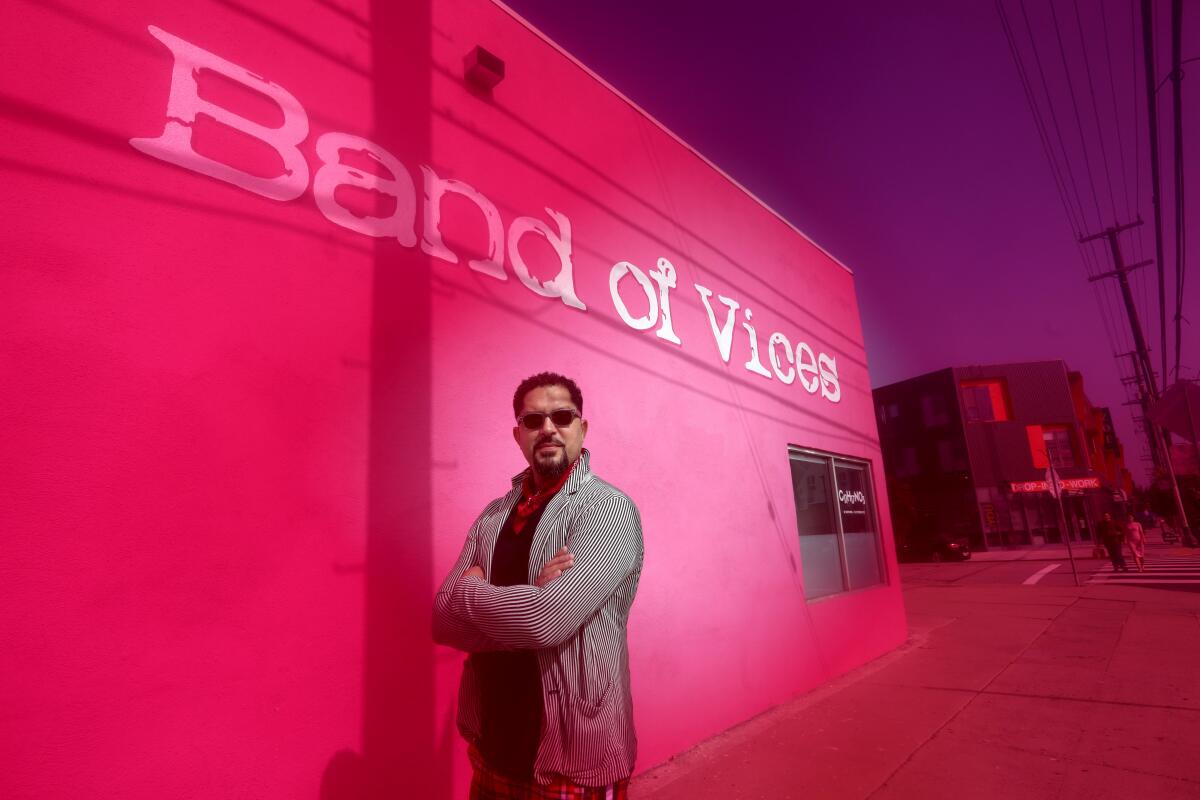
- Share via
Terrell Tilford likes strolling the streets around his art gallery, Band of Vices. As West Adams rapidly changes, walking lets him check in on his neighbors.
He’ll exchange waves with the guys at Tak Collision, the autobody shop across the street, or rap for a while with the staff at Delicious Pizza one block over. He’ll hit up Vees Cafe for its breakfast burritos and browse the selection at Adams Wine Shop.
Last month, Tilford, 52, was headed back from a quick stroll for milk when he stopped dead in his tracks. On one side of Band of Vices’ bright pink building, someone had spray-painted — in big black letters: “What’s all this white people s—!!!”
The paint hadn’t even dried yet.
Seen by some activists as vanguards of encroaching gentrification, art galleries in recent years have become polarizing institutions in working-class neighborhoods from South L.A. to the Eastside.
“I just couldn’t believe it,” Tilford said. “It felt like an immediate assault.”
Even more so because, for years, his gallery had featured the work of local artists of color. And then there was the unavoidable irony in the accusation painted on the wall.
Tilford not only grew up in West Adams, but he is a Black man.
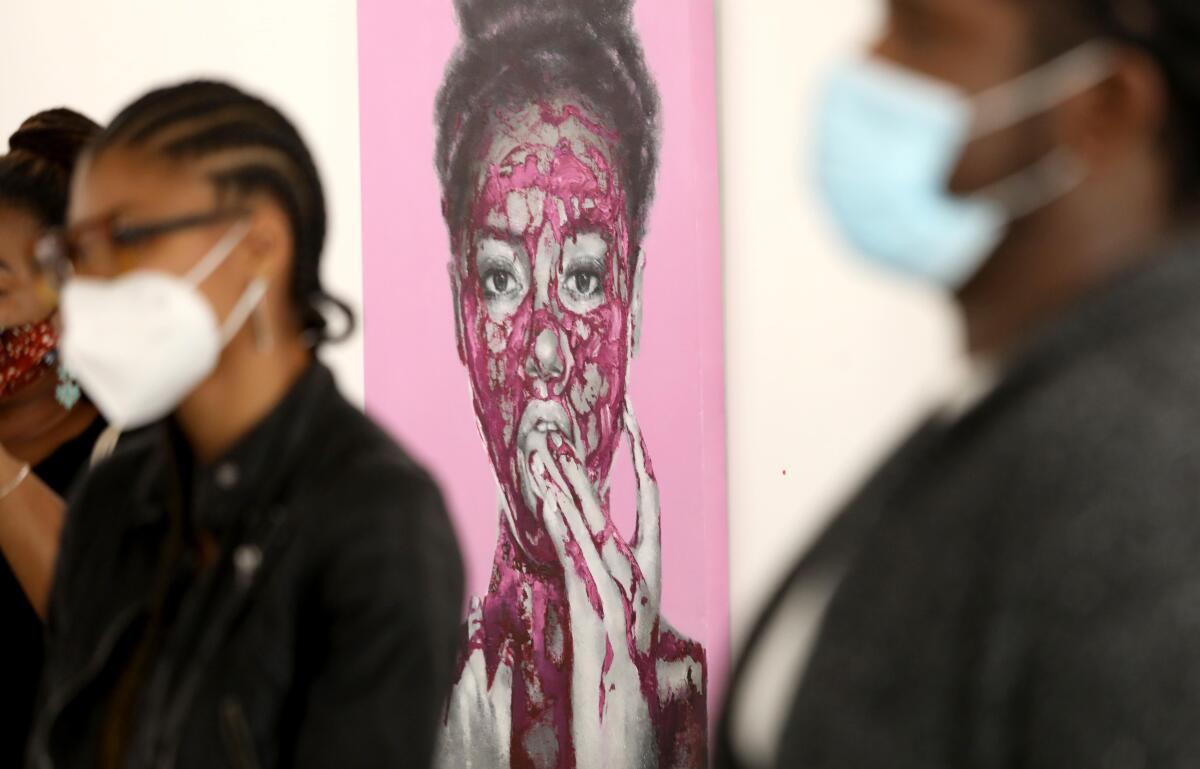
In West Adams, many residents have a story of a favorite business replaced or a loved one who was pushed out to the Inland Empire or Texas. They wonder when it will be their turn.
Shocked by the vandalism, Tilford walked into his gallery and sat for a moment, gathering his thoughts.
“I just tried to process it. I was really trying to just tap into the psychology of whoever it could be,” he said. “I can’t tell you if it was a white person, a Black person, or a brown person because everybody has a different relationship to what’s happening in the neighborhood. And we are all participants in some level of it.”
::
In recent years, trendy eateries and shops have opened along West Adams Boulevard. Band of Vices sits on a block with Alta, a swanky “Cali soul food” restaurant, and Adams Wine Shop, both of which opened in 2018. Delicious Pizza arrived in 2015 and four years later, in 2019, saw the arrival of Mizlala, a Mediterranean grill.
Along with Tilford’s art gallery, it made for an unusual collection of businesses for a working-class South L.A. neighborhood.
Over the last 10 years, average home values have also skyrocketed, from about $330,000 to about $1 million today, according to Zillow.
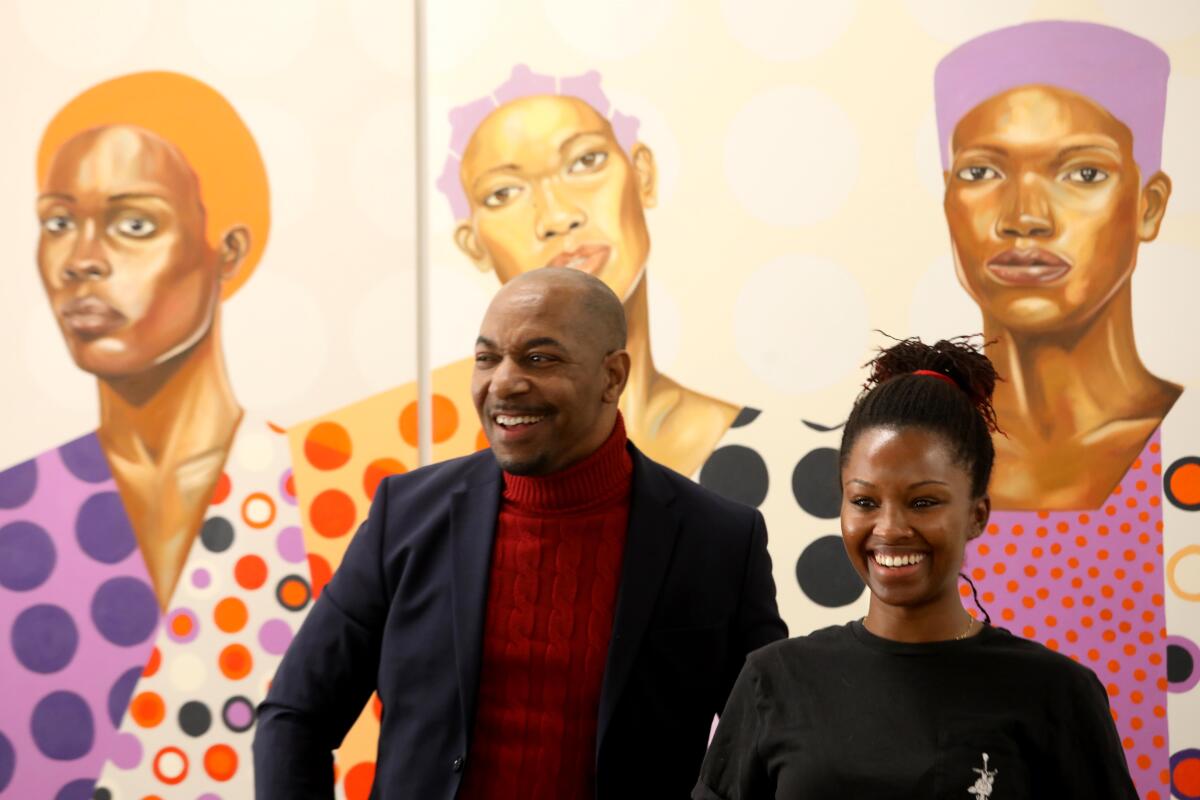
“People have definitely been priced out. Gentrification is a real thing,” said Zale Johnson, a real estate agent who both lives and sells homes in West Adams. “I’ve been in West Adams for about 20 years and what I’ve seen in recent years is older people, Black and Latino people, selling to downsize or move out of state.”
Johnson adds that mostly young families look to buy in West Adams. Most who can afford the asking price are white, he said.
“On my street, we had one Black couple move in recently,” Johnson said. “That’s rare.”
Laura Meyers, a historian with the West Adams Heritage Assn., said that the original West Adams district was a small neighborhood situated between Figueroa Street on the east and West Boulevard (just west of Crenshaw Boulevard) on the west. It was once the wealthiest district in the city, home to railroad magnates and industrialists who built resplendent mansions.
Those early residents left for the Westside beginning in the 1910s, making way for wealthy Black buyers. By the 1940s, the area was nicknamed “Sugar Hill” and was home to the likes of Hattie McDaniel, the first Black American to win an Academy Award, and boxer Joe Louis.
It maintained its reputation as a well-to-do Black neighborhood into the 1960s, when construction of the Santa Monica Freeway cut through the neighborhood — destroying dozens of homes in the process. Since then, what’s known as West Adams has expanded south below Interstate 10 to include areas previously cut off by the freeway.
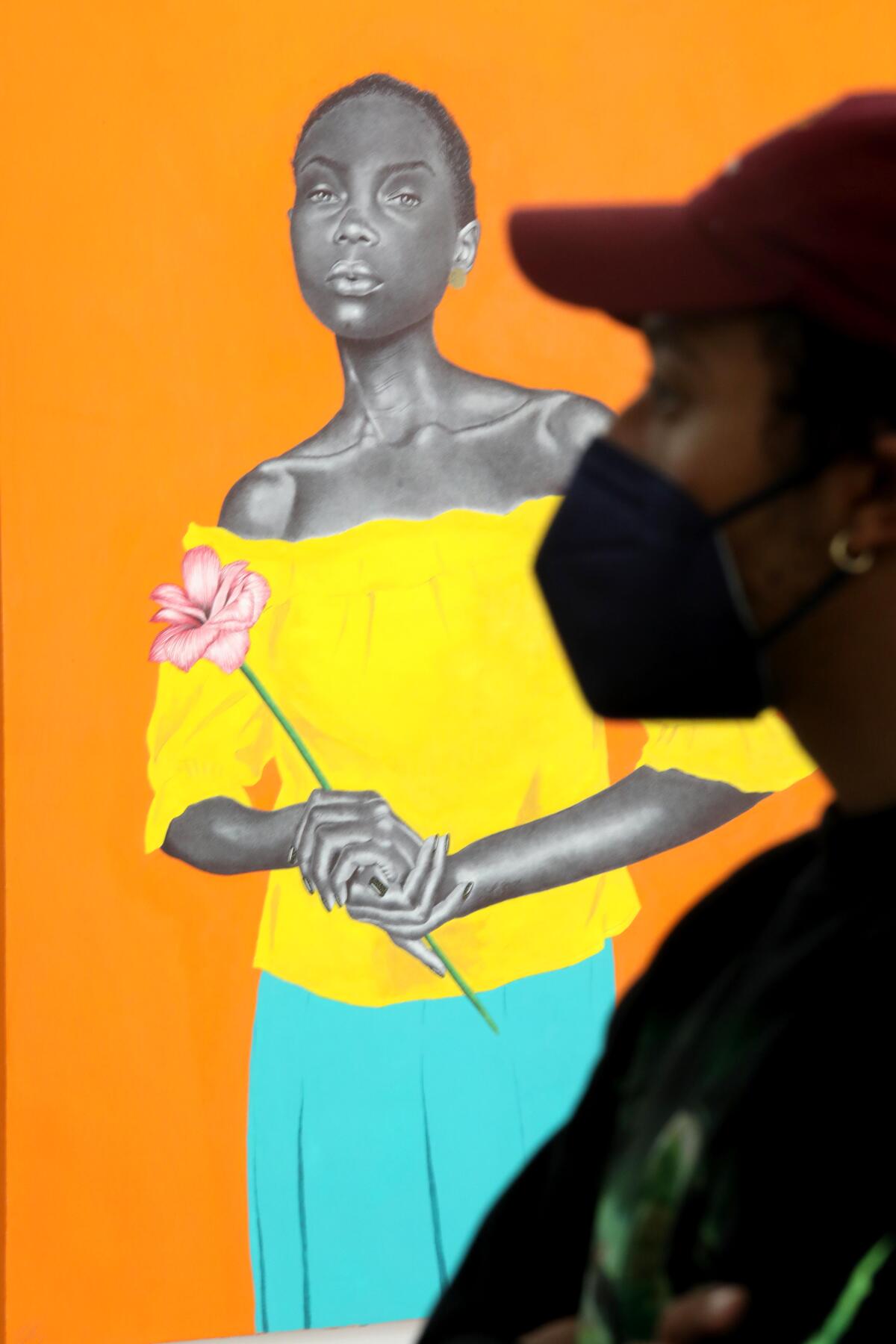
Today, it’s flanked by Jefferson Park and Leimert Park to the east, Culver City to the west, Baldwin Hills and Crenshaw to the south and Mid-City to the north. It’s a diverse working-class neighborhood where Latinos make up more than half the residents; the Black population now makes up just under 40% of West Adams.
Plans for development in the area have picked up regardless of fears and tension. Bike lanes are coming to a two-mile stretch of Adams Boulevard between Fairfax Avenue and Crenshaw Boulevard. Developer CIM Group also has dozens of projects underway in West Adams, including offices, a hotel and apartment buildings.
“If you look at the history of this entire area, it changes just about every decade,” Meyers said. “The current changes are just happening so quickly.”
Yolanda Davis-Overstreet, vice president of the West Adams Neighborhood Council, lives with her 98-year-old mother in a house her parents purchased in 1960. She doesn’t condone vandalism. She supports Band of Vices, she said. But she’s seen how wound up people get over the specter of gentrification.
“People are frustrated. People are traumatized,” she said. “This kind of stuff is people acting out because nobody’s seeing them.”
Band of Vices is at the heart of what looks to be the new West Adams. Tilford is eager to be a presence in the neighborhood, but he faces the threat of backlash from residents who perceive any renewal as a step toward removal.
What happened to his business made him think about people’s fears. But it also made him angry.
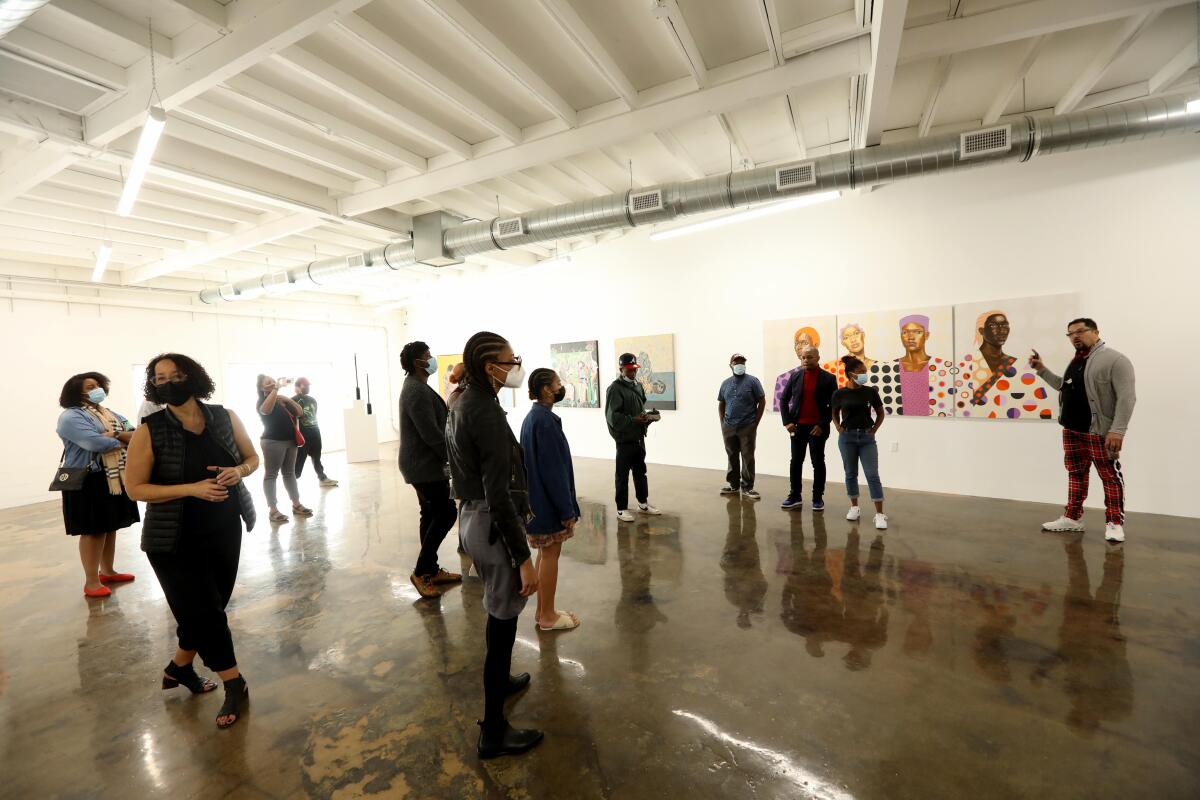
“People are afraid of what they don’t know and may not necessarily have the tools to answer their own questions. ‘What the f— is this big pink building?’” he said. “Yeah, if you’ve never been inside, you don’t know. But once you come inside, hopefully, you’ll feel at home.”
::
The most ferocious recent protests in L.A. over art galleries and gentrification began about six years ago in Boyle Heights.
Activists protested 11 art galleries in that neighborhood, seeing them as a kind of Trojan horse for a larger wave of change that could push out working poor families. Activists insisted that what the neighborhood needed was more affordable housing and services like grocery stores and laundromats. In one case, someone sprayed “f— white art” on a gallery door.
The protesters were as forceful as they were uncompromising — and their tactics worked: The galleries moved away or closed.
Eva Chimento was there.
Her space, Chimento Contemporary, opened in Boyle Heights in 2015 and was one of the targets.
Protesters followed her into West Adams, where Chimento Contemporary relocated in 2018, and didn’t let up until the gallery closed last year. In the end, it was a casualty not of dogged activists but of the onset of the COVID-19 pandemic.
But the experience rattled her. “It was traumatic,” Chimento said.
Subscribers get early access to this story
We’re offering L.A. Times subscribers first access to our best journalism. Thank you for your support.
After much reflection about how to be in neighborhoods like West Adams responsibly, she made the decision to join the team at Band of Vices, becoming the art gallery’s director.
“I’ve learned from the experiences I’ve had. I’ve also learned … about what it means to work in the art world,” she said. “I’ve learned that community is very important and that’s why I’m here at Band of Vices, because it’s really of and for this community.”
Tilford was raised between his father’s home near 9th Avenue and Adams Boulevard and his mother’s on Washington Boulevard.
“I remember when it was Crips and Bloods fighting with the Harpys, a Mexican gang,” Tilford said. “I grew up in this neighborhood. I’ve seen the change.”
He left for UC Berkeley and then Rutgers University, where he earned a master of fine arts in theater.
Tilford became an actor, appearing on a number of TV shows over the years, including “Days of Our Lives,” “Soul Food” and “Single Ladies.” His success allowed him to amass a sizable collection of contemporary and modern art.
“It just became a business,” Tilford said. “I never set up for that, but I wanted to help support visual artists in the same way that people supported me as an actor.”
He opened his first gallery, the Tilford Art Group, in 1999 in New York. It closed in 2010 when he moved back to Los Angeles. Tilford rebranded the operation as Band of Vices and set up shop first in Picfair Village on Pico and Hauser boulevards in 2015. The gallery moved next to a smaller space across the street from its current location in 2018.
“I like to be off the beaten path and in a place that we, Black and brown people, have access to and where we feel comfortable,” he said.
Band of Vices moved to its current location — a 4,800-square-foot building with 14-foot ceilings — earlier this year. Tilford decided to paint the exterior bubble gum pink.
It was a stab against stereotypes.
“People of color are constantly seen as defiant and strong,” he said. “But we’re also tender and loving and compassionate. That is what I want this space to exude.”

West Adams is home to a number of galleries. Band of Vices is one of two owned by a person of color — and the only one operated by someone from the neighborhood.
After the shock of the vandalism wore off, Tilford thought about responding.
“I wanted to paint ‘We Black’ on top of the message, but that would just encourage a conversation on our walls,” he said.
Instead, he simply painted over the graffiti. Tilford has since tried to dismiss what happened as a blip. But he tenses up when he talks about it.
“I’m a Black person; I can’t gentrify s—,” he said. “If anything, I’m beautifying, and I’m magnifying. My presence is my activism. A Black-owned art gallery in this neighborhood is my activism.”
More to Read
Sign up for Essential California
The most important California stories and recommendations in your inbox every morning.
You may occasionally receive promotional content from the Los Angeles Times.











